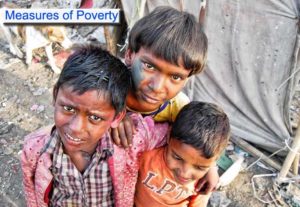 Poverty is a complex phenomenon and cannot be measured by a single variable. Money value denotes the objective standard of poverty measurement but it alone cannot measure the poverty. Before moving on to the section “ measures of poverty ”, let’s us understand the rationale behind the measurement of poverty.
Poverty is a complex phenomenon and cannot be measured by a single variable. Money value denotes the objective standard of poverty measurement but it alone cannot measure the poverty. Before moving on to the section “ measures of poverty ”, let’s us understand the rationale behind the measurement of poverty.
Why to measure poverty?
About one-fourth of Indian population is poor thus it is beneficial to measure poverty due to following reasons:
- It serves as powerful tool to focus the attention of government and policy makers on living condition of poor.
- It helps government to target the section of society which is poor. For example, if agriculturalists are poor then government can strengthen the agriculture policy to bring them out of poverty.
- It helps international agencies to target the poor region of world with their policy interventions.
- It helps government to evaluate the programmes and policies implemented to eradicate the poverty.
Measures of Poverty
Let’s now briefly discuss the measures of poverty:
- Per Capita Income Concept
Per capita income can be used as measure of household welfare. A threshold level of income also called Poverty Line is defined to differentiate between poor and non-poor. For example, if we say poverty line in terms of per capita income is Rs 1000, then any household earning below Rs 1000 is considered as poor.
- Basic Need Concept
In this approach, the basic needs of the individual such as food, housing, health services, education, clothing etc. are used as measure of welfare. If these basic needs are not fulfilled then individual is considered poor.
- Per Capita Food Consumption
In this approach, the household’s propensity to consume food is used to measure welfare.
- Calorie Concept
This approach is based on calorie intake of individual. Every individual have some basic nutritional requirement. To satisfy this requirement, a basket of goods is selected in such a way so as to maximise the nutrient intake at lowest possible cost. Household which are unable to incur the cost of basket of goods are categorised as poor.
Poverty Ratio or Head Count Ratio
Poverty Ratio (PR) or Head Count Ratio (HCR) is defined as the proportion of poor to the total population. It measures the incidence of poverty and helps to understand whether the poverty is reducing or not.

Poverty Gap
It is the average of the difference between the income of each individual poor and poverty line. Thus it measures how much money is required to bring every poor person out of poverty in a country.
Measurement of Poverty in India
The various endeavors have been made in India to measure the poverty. Some of these are:
- “The Task Force on Projection of Needs and Effective Consumption Demand” by Planning Commission in 1979 defines Poverty Line as per capita expenditure level at which average per capita per day calorie intake is 2400 calorie for rural areas and 21 calories for urban areas.
- Suresh Tendulkar panel’s recommendations in 2011-12, the poverty line had been fixed at Rs 27 in rural areas and Rs 33 in urban areas. About 22% of the population lives below poverty line.
- Rangarajan committee raised these limits to Rs.32 and Rs.47, respectively, and worked out poverty line at close to 30%
Download this article as PDF
Here are some useful articles for you to read next:
Click to go to RBI Grade B Preparation Page
Tags: measures of poverty, how is poverty measured, ways to measure poverty, poverty measurement methods, measures of poverty and inequality, measurement of poverty in india, measurement of poverty pdf, how is poverty measured in the world, how do we measure poverty, approaches used to measure poverty, different measures of poverty, poverty and its measurement, approaches to measure poverty